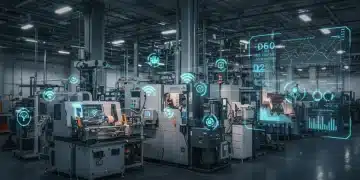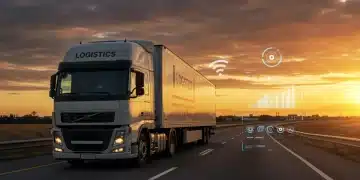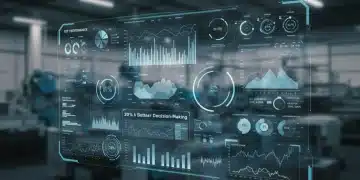Connected Cars: IoT Advancements Driving Safety & Efficiency by 2025
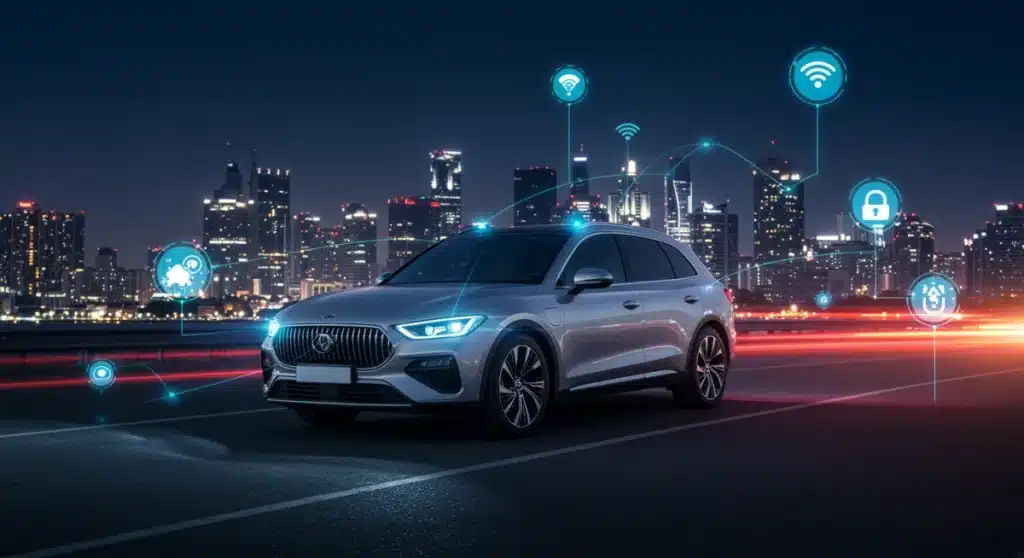
By 2025, connected cars in the US will leverage four major IoT advancements to significantly boost automotive safety and efficiency, including V2X communication, predictive maintenance, advanced sensor fusion, and AI-driven personalized experiences, fundamentally reshaping the driving landscape.
The automotive industry is on the cusp of a profound transformation, with Connected Car IoT Advancements poised to redefine driving experiences by 2025. These innovations are not just about convenience; they are fundamentally enhancing safety and efficiency on American roads. From real-time data exchange to proactive vehicle maintenance, the integration of the Internet of Things (IoT) is driving a new era for vehicles.
The Dawn of Hyper-Connected Vehicles: Redefining Automotive Safety and Efficiency
The concept of a “connected car” has evolved far beyond simple infotainment systems. Today, it encompasses a sophisticated network of sensors, software, and communication technologies that allow vehicles to collect, send, and receive data, interacting with their environment and other entities. This hyper-connectivity is laying the groundwork for unprecedented levels of safety and operational efficiency, promising a future where accidents are minimized and journeys are optimized.
As we approach 2025, the advancements in IoT are accelerating, pushing the boundaries of what vehicles can do. These technologies are not merely incremental improvements but represent a paradigm shift in how we perceive and interact with our cars. The focus is squarely on creating a safer, more responsive, and ultimately more efficient transportation ecosystem.
The integration of IoT in connected cars is a complex undertaking, involving numerous stakeholders from automotive manufacturers and technology providers to infrastructure developers and regulatory bodies. The collaborative effort aims to standardize protocols and ensure seamless interoperability, which is crucial for the widespread adoption and effectiveness of these advanced systems. This interconnected future depends on robust, secure, and reliable data exchange.
Vehicle-to-Everything (V2X) Communication: The Cornerstone of Future Road Safety
One of the most impactful IoT advancements for connected cars is the widespread adoption and refinement of Vehicle-to-Everything (V2X) communication. This groundbreaking technology enables vehicles to communicate directly with other vehicles (V2V), infrastructure (V2I), pedestrians (V2P), and even the network (V2N), creating a 360-degree awareness that significantly enhances road safety.
V2X communication operates by exchanging critical data in real-time. This includes information about speed, location, direction, and even potential hazards. Imagine a scenario where your car receives an alert about a sudden brake by a vehicle several cars ahead, even before you can see it. Or perhaps a notification about a pedestrian stepping onto the road from behind a parked car. These capabilities are moving from concept to reality, promising to drastically reduce collisions and improve traffic flow.
How V2X enhances safety and efficiency
- Collision Avoidance: Real-time data exchange allows vehicles to detect potential collision risks earlier, triggering warnings or even autonomous emergency braking.
- Traffic Flow Optimization: By communicating with traffic lights and road sensors, cars can adjust their speed to maintain optimal flow, reducing congestion and fuel consumption.
- Hazard Warnings: Vehicles can share information about road conditions, accidents, or construction zones, alerting other drivers in the vicinity.
- Vulnerable Road User Protection: V2P technology can detect pedestrians and cyclists, providing warnings to drivers and potentially preventing accidents.
The deployment of V2X technology relies on robust communication standards, such as Dedicated Short-Range Communications (DSRC) and Cellular V2X (C-V2X). While DSRC has been a long-standing standard, C-V2X, leveraging 5G networks, is gaining traction due to its higher bandwidth and lower latency, offering even greater potential for real-time data processing and decision-making. These technologies are foundational to the future of smart mobility, enabling proactive safety measures.
The integration of V2X into connected cars by 2025 is not just about preventing accidents; it’s also about creating a more intelligent and responsive transportation system. This advancement will allow vehicles to anticipate and react to changing road conditions, making driving safer and more efficient for everyone. The continuous flow of data through V2X will be instrumental in building truly autonomous driving systems in the long run.
Predictive Maintenance and Diagnostics: Ensuring Vehicle Reliability and Longevity
Another significant IoT advancement transforming connected cars is the rise of predictive maintenance and advanced diagnostics. Traditionally, vehicle maintenance has been reactive, relying on scheduled service intervals or responding to warning lights. With IoT, cars are becoming proactive, continuously monitoring their own health and predicting potential failures before they occur.
Connected cars are equipped with an array of sensors that collect data on various components, including the engine, transmission, brakes, tires, and battery. This data is then transmitted to the cloud, where sophisticated algorithms analyze it for anomalies and patterns indicative of impending issues. This allows for timely alerts to both the driver and service centers, enabling preventative action rather than costly repairs after a breakdown.
Benefits of predictive maintenance
- Reduced Downtime: By addressing minor issues before they escalate, vehicles spend less time in the repair shop.
- Cost Savings: Preventative maintenance is often less expensive than emergency repairs for catastrophic failures.
- Enhanced Safety: Identifying and fixing potential mechanical issues proactively prevents failures that could compromise safety on the road.
- Extended Vehicle Lifespan: Regular, data-driven maintenance helps keep components in optimal condition, extending the overall life of the vehicle.

Automakers are increasingly integrating these systems into their new models, providing owners with peace of mind and more efficient vehicle management. For example, a connected car might detect unusual vibrations in a wheel bearing and notify the driver that service is recommended within the next few weeks, allowing them to schedule an appointment at their convenience. This level of insight was previously unavailable, marking a significant leap in vehicle care.
The evolution of predictive maintenance through IoT is a game-changer for car owners and fleet managers alike. By 2025, it will be standard practice for connected cars to offer detailed health reports and maintenance recommendations, moving away from generalized service schedules to highly personalized and data-driven upkeep. This ensures not only the reliability of the vehicle but also contributes significantly to overall road safety by keeping cars in optimal working condition.
Advanced Sensor Fusion and AI: Smarter Perception for Autonomous Features
The push towards more advanced driver-assistance systems (ADAS) and eventually fully autonomous driving relies heavily on sophisticated perception capabilities. This is where advanced sensor fusion, powered by artificial intelligence (AI), becomes a critical IoT advancement for connected cars. Sensor fusion combines data from multiple types of sensors – cameras, radar, lidar, and ultrasonic – to create a comprehensive and highly accurate understanding of the vehicle’s surroundings.
Each sensor type has its strengths and weaknesses. Cameras provide rich visual detail but can be affected by poor lighting or weather. Radar excels at detecting distance and speed in adverse conditions but lacks fine detail. Lidar offers precise 3D mapping but can be costly. By fusing the data from these diverse sources, AI algorithms can overcome individual sensor limitations, providing a more robust, reliable, and holistic environmental model for the connected car.
The role of AI in sensor fusion
- Enhanced Object Detection: AI algorithms can identify and classify objects (vehicles, pedestrians, cyclists, road signs) with greater accuracy than individual sensors.
- Improved Situational Awareness: By processing vast amounts of fused data, AI creates a detailed real-time map of the vehicle’s environment, including dynamic elements.
- Redundancy and Reliability: If one sensor fails or is obscured, the system can still rely on data from other sensors, ensuring continuous and safe operation.
- Predictive Capabilities: AI can analyze movement patterns to predict the behavior of other road users, allowing the connected car to react proactively.
By 2025, the integration of advanced sensor fusion and AI will enable connected cars to perform complex maneuvers with greater confidence and safety. This includes features like adaptive cruise control that can handle stop-and-go traffic, advanced lane-keeping assist, and automated parking systems. These capabilities are crucial steps on the path to widespread autonomous vehicle deployment, making our roads safer and driving less stressful.
The continuous development of AI models and the increasing computational power within connected cars are making these sophisticated perception systems a reality. The ability of connected cars to ‘see’ and ‘understand’ their environment in such detail is a monumental leap, profoundly impacting both safety and efficiency by reducing human error and optimizing driving decisions. This forms a core component of the next generation of intelligent vehicles.
AI-Driven Personalized Experiences: Tailoring the Drive to Each User
Beyond safety and efficiency, IoT advancements in connected cars are also paving the way for highly personalized driving experiences, largely driven by artificial intelligence. By 2025, our cars will be more than just transportation; they will be intelligent companions that adapt to our preferences, habits, and even our moods, creating a truly unique and comfortable cabin environment.
AI systems in connected cars learn from driver behavior, adjusting everything from seat positions and mirror settings to climate control and infotainment preferences. They can anticipate needs, suggest routes based on real-time traffic and personal preferences, and even provide proactive notifications. This personalization extends to in-car entertainment, productivity tools, and even well-being features, transforming the vehicle into a personalized mobile hub.
Elements of AI-driven personalization
- Adaptive Cabin Environment: AI learns preferred temperature, lighting, and even ambient sounds for different driving conditions or times of day.
- Personalized Infotainment: Music, podcasts, and news recommendations tailored to the driver’s taste and current context.
- Context-Aware Navigation: Routes suggested not just for speed, but also considering personal POIs, fuel efficiency, or scenic preferences.
- Proactive Wellness Features: Monitoring driver fatigue or stress levels and suggesting breaks or offering calming ambient settings.
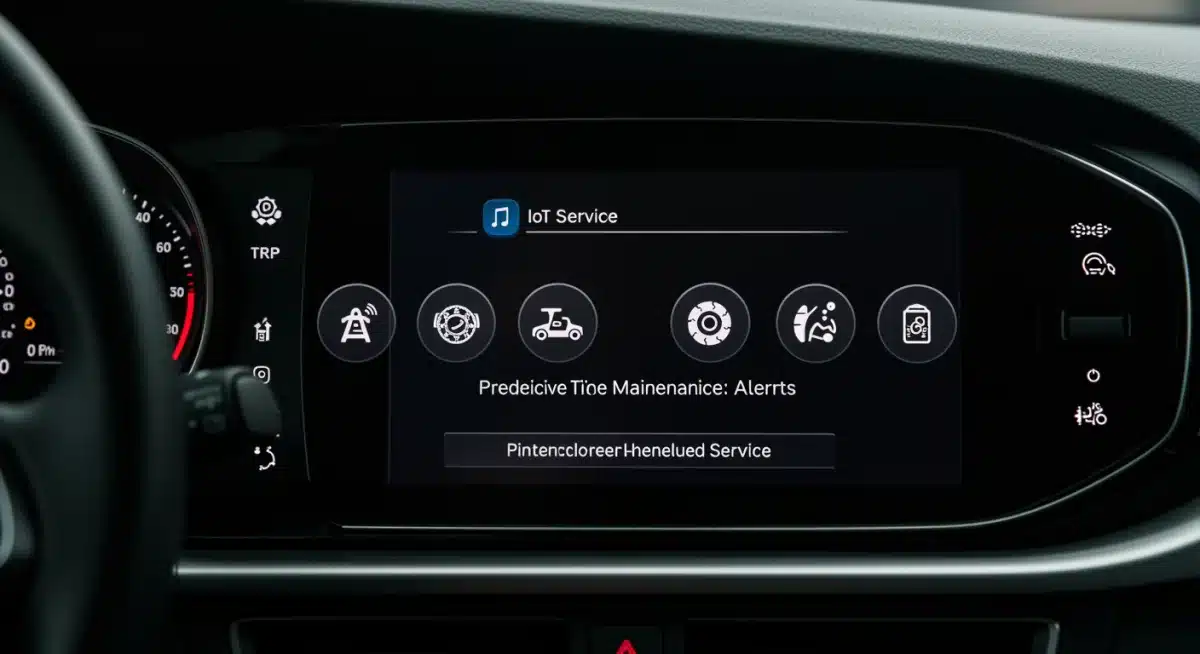
The data collected by IoT sensors within the cabin and from external sources feeds these AI systems, allowing them to continuously refine their understanding of the user. This creates a seamless and intuitive interaction between the driver and the vehicle, reducing distractions and enhancing the overall driving experience. For example, if the car detects a driver frequently takes calls at a certain location, it might proactively suggest a hands-free setup or re-route to a quieter street.
While privacy concerns around data collection are valid and being addressed through robust security protocols and user consent mechanisms, the benefits of AI-driven personalization are significant. By 2025, connected cars will offer an unparalleled level of comfort and convenience, making every journey more enjoyable and tailored to the individual. This personalized approach is a key differentiator in the evolving automotive landscape, moving beyond mere functionality to offer an experience that anticipates and serves individual needs.
Cybersecurity and Data Privacy: Fundamental Challenges for Connected Car IoT Advancements
As connected cars become increasingly sophisticated and reliant on IoT, the issues of cybersecurity and data privacy rise to paramount importance. The vast amounts of data generated and exchanged by these vehicles, from personal driving habits to location data and even biometric information, present significant security risks if not properly managed. Protecting this sensitive information from breaches and unauthorized access is crucial for maintaining consumer trust and ensuring the integrity of the entire connected car ecosystem.
Cyberattacks on connected cars could range from unauthorized access to personal data to malicious interference with vehicle control systems, posing severe safety risks. Therefore, robust cybersecurity measures are not optional; they are a fundamental requirement for the widespread adoption of IoT advancements in the automotive sector. The industry is actively developing multi-layered security architectures, including encryption, secure boot processes, intrusion detection systems, and over-the-air (OTA) updates to patch vulnerabilities promptly.
Key cybersecurity and privacy considerations
- Data Encryption: Ensuring all data transmitted to and from the vehicle is encrypted to prevent eavesdropping and tampering.
- Secure Software Updates: Implementing secure OTA update mechanisms to deliver patches and new features without compromising vehicle integrity.
- Access Control: Strict authentication and authorization protocols to prevent unauthorized access to vehicle systems and data.
- Privacy by Design: Integrating privacy considerations into the design of connected car systems from the outset, including data minimization and anonymization techniques.
Regulatory bodies in the United States and globally are also developing frameworks and standards to address these challenges. These regulations aim to establish clear guidelines for data handling, security protocols, and consumer rights regarding their vehicle data. Compliance with these evolving standards is critical for automakers and technology providers to operate responsibly and legally within the connected car landscape.
By 2025, the focus on cybersecurity and data privacy will intensify, becoming a competitive differentiator for connected car manufacturers. Consumers will increasingly demand assurances that their personal and vehicle data is secure and handled responsibly. The continued development of advanced security solutions and a proactive approach to potential threats are essential for the long-term success and trustworthiness of Connected Car IoT Advancements. This foundational aspect underpins all other innovations.
Infrastructure Readiness and Regulatory Landscape: Paving the Way for Mass Adoption
The full potential of Connected Car IoT Advancements by 2025 depends not only on technological innovation within vehicles but also on the readiness of external infrastructure and a supportive regulatory landscape. The widespread deployment of V2X communication, for instance, requires significant investment in smart road infrastructure, including intelligent traffic lights, roadside units (RSUs), and robust cellular networks, particularly 5G.
Cities and states across the United States are already investing in smart city initiatives that include upgrading transportation infrastructure to support connected vehicle technologies. This involves deploying sensors, cameras, and communication devices along roadways to facilitate real-time data exchange between vehicles and the environment. Without this foundational infrastructure, many of the advanced features of connected cars, particularly those related to traffic management and hazard warnings, cannot operate effectively.
Challenges and progress in infrastructure and regulation
- 5G Deployment: The expansion of 5G networks is vital for high-bandwidth, low-latency communication required by C-V2X and other data-intensive applications.
- Standardization: Establishing common standards for V2X communication protocols and data formats is crucial for interoperability across different manufacturers and regions.
- Government Funding: Public-private partnerships and government funding are necessary to accelerate the deployment of smart infrastructure.
- Regulatory Harmonization: Developing consistent regulations concerning autonomous features, data privacy, and cybersecurity across different jurisdictions.
The regulatory landscape is continually evolving to keep pace with rapid technological advancements. Government agencies are working to create clear guidelines for the testing, deployment, and operation of connected and autonomous vehicles. This includes addressing legal liabilities, ethical considerations, and ensuring public safety. The goal is to foster innovation while establishing a framework that protects consumers and promotes responsible technology adoption.
By 2025, significant progress is expected in both infrastructure development and regulatory clarity, although challenges will remain. The collaborative efforts between automakers, technology companies, and government bodies are essential to create an environment where connected cars can thrive. This collective commitment ensures that the benefits of IoT in automotive safety and efficiency are realized on a broad scale, transforming the future of transportation for everyone.
Key Advancement |
Primary Impact |
|---|---|
V2X Communication |
Real-time data exchange for enhanced collision avoidance and traffic flow. |
Predictive Maintenance |
Proactive vehicle diagnostics, reducing breakdowns and extending lifespan. |
Advanced Sensor Fusion & AI |
Comprehensive environmental perception for smarter autonomous features. |
AI-Driven Personalization |
Customized driving experiences and adaptive in-cabin environments. |
Frequently Asked Questions about Connected Car IoT Advancements
V2X communication significantly enhances safety by enabling real-time data exchange between vehicles, infrastructure, and pedestrians. This allows for proactive collision avoidance, optimized traffic flow, and immediate hazard warnings, making roads safer and commutes more efficient for all users.
Predictive maintenance uses IoT sensors and AI to continuously monitor vehicle health and anticipate potential component failures before they occur. This proactive approach reduces unexpected breakdowns, lowers repair costs, extends the vehicle’s lifespan, and contributes to overall road safety by keeping cars in optimal condition.
AI is crucial for sensor fusion, processing data from multiple sensors (cameras, radar, lidar) to create a comprehensive understanding of the vehicle’s environment. This enables superior object detection, improved situational awareness, and predictive capabilities essential for advanced driver-assistance systems and autonomous driving functionalities, enhancing safety and decision-making.
Yes, data privacy is a significant concern due to the vast amount of personal and vehicular data collected. The industry is addressing this through robust cybersecurity measures like encryption, secure software updates, and privacy-by-design principles. Regulatory frameworks are also evolving to protect consumer data and ensure responsible handling of sensitive information.
Supporting these IoT advancements requires significant investment in smart road infrastructure, including intelligent traffic lights, roadside units (RSUs), and robust 5G cellular networks. These components facilitate seamless real-time data exchange, which is essential for V2X communication and other advanced connected car features to function efficiently and safely.
What happens next
The trajectory of Connected Car IoT Advancements indicates a rapid evolution towards increasingly intelligent and integrated vehicles. As 2025 approaches, we anticipate continued progress in standardizing V2X protocols, further deployment of 5G infrastructure, and more sophisticated AI algorithms for both safety and personalized experiences. Readers should monitor legislative developments concerning autonomous vehicle regulations and ongoing public-private partnerships focused on smart city infrastructure, as these will significantly shape the pace and scope of future automotive innovation.

